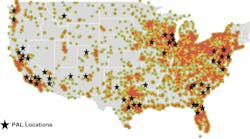How's it for fuel economy? Mileage? Durability? Retreadability? Irregular Wear?… We're always trying to stretch the tire envelope with technology,” says Guy Walenga, engineering manager, commercial products for Bridgestone/Firestone North American Tire, LLC.
“For tire engineers,” he continues, “the biggest technical challenge is to keep building new products to meet market needs — while reducing rolling resistance for fuel economy for users, trying to make the tire lighter for OEMs, and retaining the durability and performance everyone knows us for.”
That sounds like a tall order but Walenga sees the challenge as all in a day's work. “Our everyday business is change,” he remarks.
Getting down to brass tacks, he stresses that tire engineering is all about working more desirable features into a product without taking away any of its existing positive aspects.
Walenga says there's a lot that goes into designing and building tires that the customer never sees. Specifically, he refers to what he calls “the original black art-compounding.”
He explains that the contribution new rubber compounds make to the tire package is vastly underrated. “We can put different features on a given tire,” says Walenga, “but a lot of people don't realize it's the work done on compounding that is extending the tire's performance envelope.”
According to Walenga, advances in compounding technology will eventually make the million-mile casing a reality. That goal is getting closer. “We already see 500,000 miles of original tread life from drive-axle tires,” he notes.
More immediately, he views the much-ballyhooed federal TREAD Act as “another boost to bringing technology to bear” on truck tires. “The big impact the TREAD Act will have on truck tires will be the requirements for air-pressure monitoring,” he explains. “But keep in mind our mantra is 'air pressure, air pressure, air pressure… Without it, you are giving away tire performance.”
He says the expectation is that the TREAD Act will add to tire expense in terms of additional hardware but “will have a positive impact by helping change for the better how tires are maintained.” However, he notes, the actual TREAD Act rulemaking regarding heavy-duty trucks is still a year or two away.
Before and after the TREAD Act, Walenga says most fleets will continue to be interested in fuel efficiency but will be “looking for miles and durability most of the time.”
Along with air pressure, Walenga says vehicle alignment has a big effect on both tire wear and fuel economy. “Man y fleets now have four to five trailers per tractor,” he points out.
“So if they are dragging around one after another poorly aligned vehicle, they will really be dragging down their fuel economy.”
Not only that, he says poor alignment also “scrubs off tread life each and every time the truck rolls.”
As for current trucking tire trends, Walenga believes the wide-base radials now starting to make inroads will remain largely a niche product “favored by operations such as tankers and bulk haulers that gross out first. That type of operator can utilize the weight savings of the wide-base tire setup the most, as well as also gain from the fuel efficiency these tires produce.
“But it's too soon to see wide-base tires sold as a fuel-saver spec alone,” he adds. “You really need the extra load savings to make it pay off.”
The way Walenga sees it, you can't know enough about tires, whether you engineer them or just buy them. “To reduce tire and fuel costs,” he advises, “it's crucial for fleet managers to be as well informed as possible on tires and what impacts them. Being educated results in not leaving anything on the table.
“Tires are worth knowing a lot about,” he adds, “from spec'ing them to repairing and retreading them. And think hard about who is taking care of your tires. Tires are the second-highest fleet cost after fuel. So why would they be taken care of by someone hired to sweep the floor. Remember, every time someone touches a truck tire, they're touching a $300 asset.”


